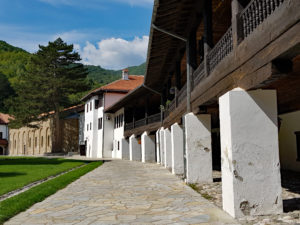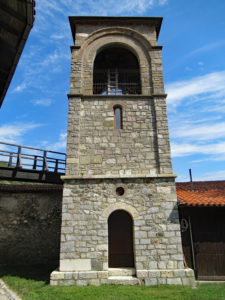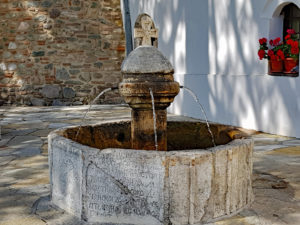On our five-day visit to Kosovo, our itinerary included a visit to the “Visoki Dečani Monastery”:https://www.decani.org/en/, founded in 1335. As a UNESCO World Heritage Site since 2004, its frescoes are said to be a real must for visitors.
On the drive from Prizren where we were staying at the “Hotel Kaçinari”:https://www.silvertraveladvisor.com/review/accommodation/203061-review-hotel-ka-inari, we crossed the Lumi Drini River and saw a market setting up on the roadside with lots of huge bags of peppers, chillies, and grapes. We stopped to have a look, but it quickly became clear that photographs were not acceptable.
The Monastery is located in the forests of the Deçan Canyon and on arrival, we had to pass through a roadblock before entering the carpark. The entrance to the complex is guarded by KFOR, an international NATO-led peacekeeping force, and passports had to be surrendered as security. We were also told we couldn’t take photos with our large camera, but mobile phone photos were OK, and we got the thumbs up for a small compact camera. Moderate dress was also required i.e. no strappy tops or shorts.
At the entrance to the church, a Japanese group of eight arrived at the same time as us, and it was agreed we would join them. This turned out well, as the monastery guide spoke in English and as the jolly Japanese tour guide had to translate, it gave us time to take in the 4,000 square metres of unrestored 14th century frescos with 1,000 individual paintings and 10,000 faces. The materials used included real gold and lapis lazuli from Afghanistan (as at “Studenica”:https://www.silvertraveladvisor.com/review/attraction/197699-review-studenica-monastery in Serbia which we’d visited earlier in the year).
The building, one of the largest medieval Serb structures, combined Byzantine, Romanesque, and Gothic features, known as the Raska style. There were three parts: the narthex, the sanctuary and the area behind the altar screen or iconostasis.
NARTHEX – A calendar of saints for every day of the year was above the door with a huge fresco of Christ and, to the left-hand side, St George. On the right-hand side was the Nemanjič family tree (a prominent Serbian dynasty in the middle ages) and in front, a large marble font containing holy water used in baptisms: entry to the nave is prohibited unless you’re baptised.
At the western door were large pillars with a griffin at the top and a lion at the bottom straddling a Christian. We were told the artist would never ever have seen a lion. The floor was onyx from the nearby town of Peja.
There were four pillars in this area, two made from solid pieces of marble and the Japanese guide remarked how difficult it must have been to move them. The monastery guide suggested rather witheringly, “perhaps not as difficult as building the Egyptian pyramids or Stonehenge”.
NAVE – The door leading into the nave was made in 1828 with the largest part being 24m wide. On the right were two tombs. The first was of King Stefan Uros III, who later became known as Stefan Dečankski, as the monastery was built during his reign. The second smaller and lower tomb was his sister, St. Jelena of Serbia, who later became Empress of Bulgaria before becoming a nun. There was also a sarcophagus, opened at 7pm on Thursday, which is well visited for its healing powers – this wasn’t included in our Bradt guidebook, but it did mention a weekly highlight being Thursday evensong.
The 11m fresco of the family tree of Jesse, is the most comprehensive and complete in Byzantine painting, and to the sides, were old and new testament stories. There was also a unique fresco of Christ with what appeared to be a weapon but was said to be a spiritual sword only.
ICONOSTASIS – This was originally from 1340 although some had been added later in the 1600s. There was a large candle holder hanging down from 8 chains and a marble throne reserved for the Kings (last used in 1924) by Alexander Karageorge (which the Japanese guide admitted was hard to pronounce). At this point, our driver who was accompanying us, told us we could take photos without the flash and we both managed to take one before being told we couldn’t. Unfortunately, we both took the same photo!
There was an ornately carved wooden cross and the guide said that a tiny piece was from the cross at Jerusalem: the Japanese guide found that hard to believe and questioned the Monastery guide a couple of times “are you sure?”. He simply rolled his eyes. There were two small chapels behind the iconostasis built in 1840 and 1844 and although one of the Japanese ladies was keen to go behind, she was told firmly, “not even nuns are allowed there”.
Before leaving we had the chance to look around the outside including the bell tower, graves, the outside of the monks’ accommodation and gift shop where we were given a taste of their home-made 45% apple brandy.










